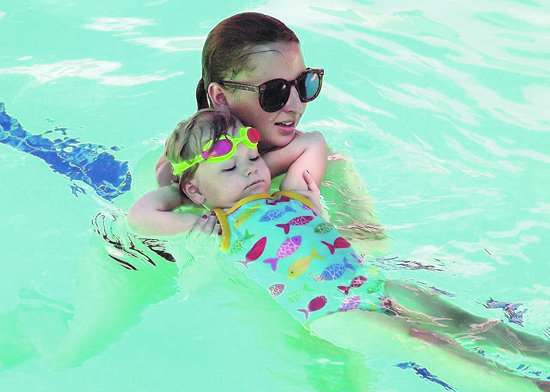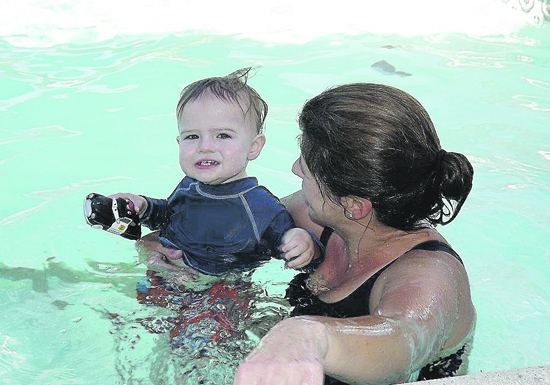 | | | June Day, 2 years and 10 months old, relaxes in the hands of instructor Briana Nicholson during her swim class at Sherman Swim School.
Photo Cathy Dausman
| | | | | | Water babies. Steve Sherman sees them almost daily. Toddlers who splash and laugh in the pool, but who are also learning independence and lifelong water safety skills.
 Sherman, of Lafayette's Sherman Swim School, figures his staff has helped a few thousand children in the last 30 to 40 years get comfortable in the water when they're young. "We give them a head start," he said, explaining that built-in reflexes help when a young child is exposed to a water environment. A child between 9 months and 1 year - the age at which his school accepts students "with a clean bill of health" - normally has enough neck strength to start the class, Sherman said, noting they have few fears and little stranger anxiety then.
Sherman, of Lafayette's Sherman Swim School, figures his staff has helped a few thousand children in the last 30 to 40 years get comfortable in the water when they're young. "We give them a head start," he said, explaining that built-in reflexes help when a young child is exposed to a water environment. A child between 9 months and 1 year - the age at which his school accepts students "with a clean bill of health" - normally has enough neck strength to start the class, Sherman said, noting they have few fears and little stranger anxiety then.
 Other Lamorinda pools offer swim lessons for children between ages 3 and 5. That is when they develop the large motor skills and maturity with which to learn skills like putting their face in the water, breath control, and how kicking moves them across the water, said Harriett Plummer of Harriett Plummer Aquatic School in Lafayette.
Other Lamorinda pools offer swim lessons for children between ages 3 and 5. That is when they develop the large motor skills and maturity with which to learn skills like putting their face in the water, breath control, and how kicking moves them across the water, said Harriett Plummer of Harriett Plummer Aquatic School in Lafayette.
 Still, 16-month-old JR Morgan happily splashed in 90 degree water at Sherman Swim, wearing a swim diaper, safe in the arms of instructor Katy Conlan. While engrossed with a plastic toy, JR was being led through a series of shallow end hops and skips, kicks and scoops, exposing him to the rudimentary dog paddle motion.
Still, 16-month-old JR Morgan happily splashed in 90 degree water at Sherman Swim, wearing a swim diaper, safe in the arms of instructor Katy Conlan. While engrossed with a plastic toy, JR was being led through a series of shallow end hops and skips, kicks and scoops, exposing him to the rudimentary dog paddle motion.
 Sitting upright, he was encouraged to watch the motion of his kicking feet, something he wouldn't see lying on his stomach, Sherman said. Soon JR was seated on the pool edge and was asked to fall into the water, toward Conlan's outstretched arms. She guided him in a semi-circle, urging him to swim back toward the pool edge "safe spot." JR's head and face were thoroughly wet, yet there was no coughing, no panic.
Sitting upright, he was encouraged to watch the motion of his kicking feet, something he wouldn't see lying on his stomach, Sherman said. Soon JR was seated on the pool edge and was asked to fall into the water, toward Conlan's outstretched arms. She guided him in a semi-circle, urging him to swim back toward the pool edge "safe spot." JR's head and face were thoroughly wet, yet there was no coughing, no panic.
 "This is the first step in the prevention of drowning," said Sherman, who distributes a safe swimming brochure by the Safer 3 Water Safety Foundation that notes, in addition to constant supervision and established pool rules, children are safer when they master swimming skills at a young age.
"This is the first step in the prevention of drowning," said Sherman, who distributes a safe swimming brochure by the Safer 3 Water Safety Foundation that notes, in addition to constant supervision and established pool rules, children are safer when they master swimming skills at a young age.
 Sherman's instructors normally work with a student for only15 minutes - the length said to be the maximum attention span for young children. Instructors use a combination of cues: verbal (counting "1...2...3..."), visual (taking a breath themselves before holding it with "balloon cheeks") and physical (a lift in the air and drop to the water motion) to prepare a student for the task ahead.
Sherman's instructors normally work with a student for only15 minutes - the length said to be the maximum attention span for young children. Instructors use a combination of cues: verbal (counting "1...2...3..."), visual (taking a breath themselves before holding it with "balloon cheeks") and physical (a lift in the air and drop to the water motion) to prepare a student for the task ahead.
 Ben Alfisi, 21 months old, was next. He started sessions when he was 10 months old, said his mother Leigh Alfisi. Big brother AJ, 3 1/2, was in the water, too, working with instructor Haley Lyon. There were tears when AJ started his classes, Alfisi said, and he wouldn't get in the water.
Ben Alfisi, 21 months old, was next. He started sessions when he was 10 months old, said his mother Leigh Alfisi. Big brother AJ, 3 1/2, was in the water, too, working with instructor Haley Lyon. There were tears when AJ started his classes, Alfisi said, and he wouldn't get in the water.
 "They actually both wouldn't get in the water at all for the first lesson. But I think Ben was feeding off of and reacting to AJ's anxiety," said Alfisi. "It was mostly AJ who was quite scared."
"They actually both wouldn't get in the water at all for the first lesson. But I think Ben was feeding off of and reacting to AJ's anxiety," said Alfisi. "It was mostly AJ who was quite scared."
 "AJ was a tough one," admitted Sherman.
"AJ was a tough one," admitted Sherman.
 "Now they love it and ask daily if it's a 'swim lesson day,'" said Alfisi, who wants her sons comfortable in the water, especially since there is a pool in their neighborhood.
"Now they love it and ask daily if it's a 'swim lesson day,'" said Alfisi, who wants her sons comfortable in the water, especially since there is a pool in their neighborhood.
 Rachel Day watched her daughter, June, who is not yet 3, begin her third session with Brianna Nicholson. "They are very gentle with their method," she said. Some of the young students even jumped off a low springboard with their instructors, and seemed unfazed by their accomplishment. But the children are never forced to do something that makes them uncomfortable.
Rachel Day watched her daughter, June, who is not yet 3, begin her third session with Brianna Nicholson. "They are very gentle with their method," she said. Some of the young students even jumped off a low springboard with their instructors, and seemed unfazed by their accomplishment. But the children are never forced to do something that makes them uncomfortable.
 "If nothing else, the children can be exposed to [swimming] and later it won't be a foreign feeling," Sherman said.
"If nothing else, the children can be exposed to [swimming] and later it won't be a foreign feeling," Sherman said.
 Water Safety Resources
Water Safety Resources
 The Safer 3 Water Safety Foundation, formerly Swim for Life Foundation, is a drowning prevention non-profit organization based in Tustin, CA. The organization's mission: Protect every life from drowning through education and heightened water safety awareness. For information about water safety, visit their website at http://www.swimforlife.org/about_us.
The Safer 3 Water Safety Foundation, formerly Swim for Life Foundation, is a drowning prevention non-profit organization based in Tustin, CA. The organization's mission: Protect every life from drowning through education and heightened water safety awareness. For information about water safety, visit their website at http://www.swimforlife.org/about_us.
 Additional water safety websites include:
Additional water safety websites include:
 http://www.redcross.org/prepare/disaster/water-safety
http://www.redcross.org/prepare/disaster/water-safety
 http://www.safekids.org/tip/water-safety-home-tips
http://www.safekids.org/tip/water-safety-home-tips

|

